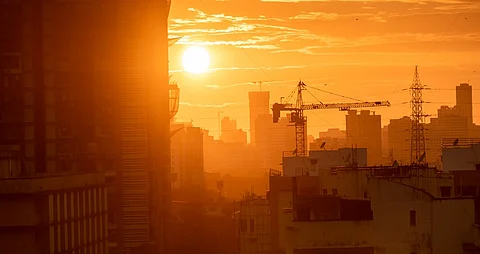

February 2025 was the hottest in India in the last 125 years, according to India Meteorological Department (IMD) data.
IMD data showed that February 2025 had also been one of the driest in the last 125 years, with less than half rainfall compared to normal.
The situation was more critical in south peninsular India and central India, while it was marginally better in East, Northeast and Northwest India.
Most weather and climate experts pointed out that the Indian trend is linked to the impact of climate change, and has been consistent with the situation last year, which was established as the warmest year ever globally. Local factors, coupled with lack of adequate western disturbances during February 2025, contributed to the trend, they added.
The IMD data, a copy of which is with this correspondent, shows that February 2025 was the “hottest … since 1901, with the average mean temperature for the month settling at 22.04°C …” The data also points out that “with 29.07°C, (last) February recorded the second-highest maximum temperature since 1901, with (an) anomaly of 1.49°C.”
Last February also saw “all-time high minimum temperature at 15.02°C, which was above normal by 1.20°C”.
A regional assessment shows that Central India was most affected by the untimely heat, as its maximum temperature rose 1.94°C above normal, while the rise in average temperature was 1.73°C.
The rising heat can be correlated with the dry spell as the country recorded deficit rainfall across the winter season (January-February) to the tune of 59 per cent, with Central India reporting large rainfall deficiency at 89.3 per cent, followed by Northwest India with 64.4 per cent of rainfall deficiency.
“With 50.2 mm of cumulative rainfall, India saw 5th lowest rainfall since 2001 during February and 18th lowest since 1901,” states the IMD report that also forecasted that “during March to May season 2025, above-normal number of heatwave days are likely over most parts of the country.”
“Above-normal heatwave days are expected over most parts of the country, including Rajasthan, Gujarat, Madhya Pradesh, Maharashtra, Uttar Pradesh, Jharkhand, West Bengal, Odisha, Chhattisgarh, Telangana, Andhra Pradesh, and parts of Karnataka and Tamil Nadu during March 2025,” reads the report.
Former director of IMD K J Ramesh pointed out that “climate change impacts are unfolding more and more strongly” and said the February trend is consistent with the dynamics.
The weather expert clarified that the summer has arrived early and reminded, that in 2024, average temperature of all the months was nearly 1.5°C or above.
“That was an eye opener, and we should have taken appropriate administrative steps to counter the situation like shifting of the school examination time within February and likewise. But unfortunately, nothing has been done so far,” said the expert.
“As we witness record-setting temperatures and severe weather patterns, February 2025 stands out as the hottest on record since 1901, and this alarming trend correlates with a staggering 59 per cent deficit in rainfall during the winter season, 89% in Central India. The impacts of urban heat are undeniable; cities are not only heating faster but becoming increasingly vulnerable to heatwaves,” stated Anjal Prakash, a climate policy expert at the Indian School of Business, Hyderabad.
Prakash, recently nominated as the lead author for the prestigious UN special report on climate change and cities, said, “The phenomenon calls for urgent climate action and innovative urban planning efforts to mitigate heat risks and adapt to the changing climate. Cities like Mumbai, Delhi, and Bengaluru are particularly vulnerable, experiencing intensified heatwaves and have insufficient infrastructure to cope with extreme conditions.”
“Immediate action is crucial. Adopting sustainable urban planning, increasing green cover, and enhancing water management systems are essential strategies to mitigate heat impacts and improve resilience in our rapidly urbanising landscape,” he further added.
“While climate change is clearly playing a key role in the increasing warming impact in India in consistence with the global trend, the quantitative attribution is not yet possible,” observed Subimal Ghosh of Indian Institute of Technology Mumbai, who pointed out that a lack of western disturbances seemed to have contributed to a dry and warm February in 2025.
“While we are already having an efficient forecasting set up, we need to ensure that early warning systems keep the community alert to such situations and facilitate taking appropriate decisions,” added Ghosh. “For example, if there is an alert of an unusually hot February, people may refrain from arranging picnics at this time of the year,” explained Ghosh.